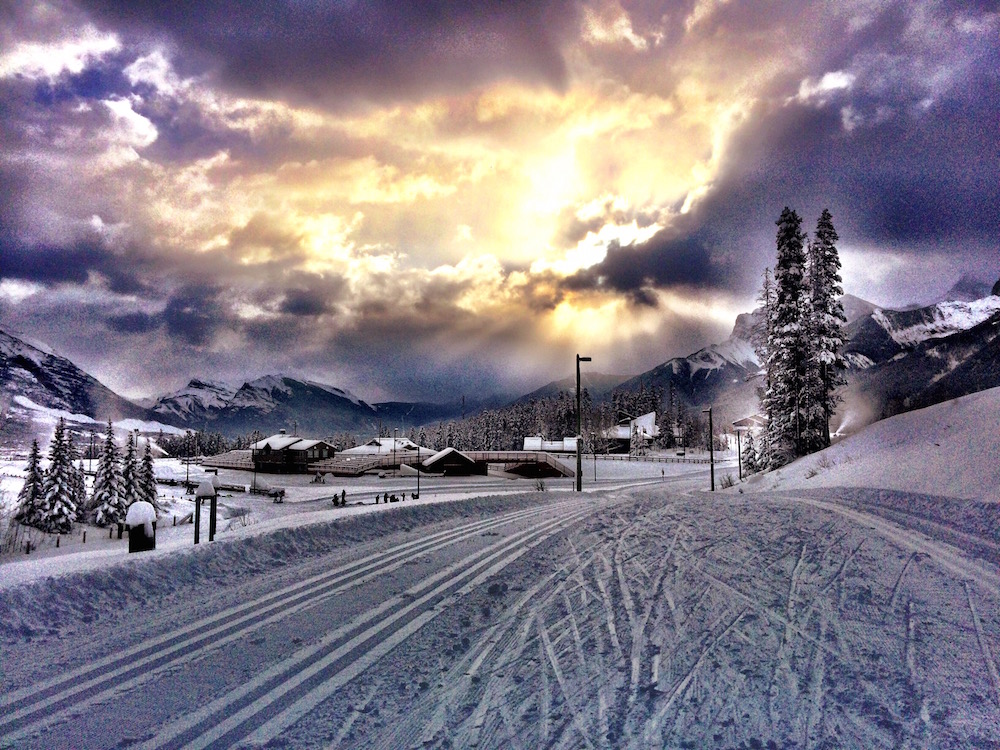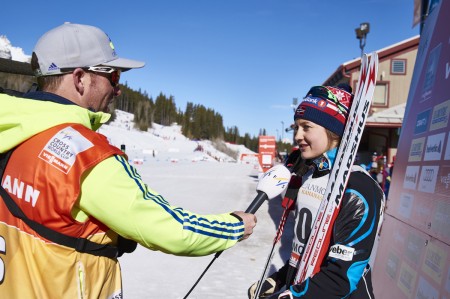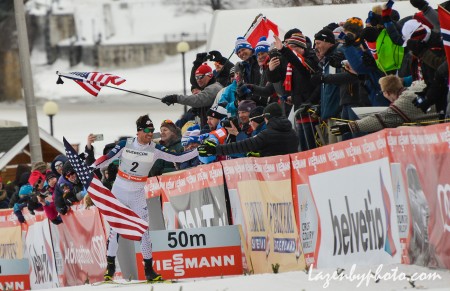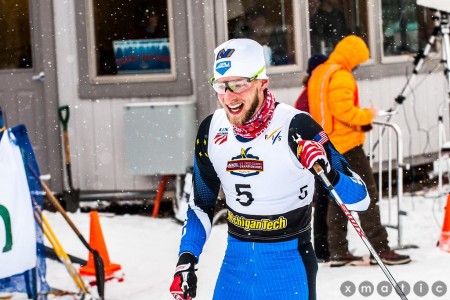
There’s an unspoken sentiment amongst many cross-country insiders that what we think of as the modern-day International Ski Federation (FIS) Cross Country World Cup is in fact a European Cup. Cross-country ski racing is more popular in Europe and commands sizable television audiences — in other words European events make money — so the arguments goes that FIS rarely schedules North American-hosted World Cups. FIS nordic races run primarily in Europe.
The first official FIS-sanctioned World Cup season was 1981/1982. The next year, 1983, Anchorage, Alaska, and Labrador City in Newfoundland and Labrador hosted the final two World Cup race weekends. In 1984, Fairbanks, Alaska, hosted another World Cup. Early on, North American venues were included on the FIS calendar in ’85, ’87, (’88 Calgary Olympics), ’89, ’91, ’94, ’95, and 2001 in Soldier Hollow. (The 2002 Salt Lake Olympics’ cross-country events were held at Soldier Hollow in Midway, Utah.)
If you crunch a bit of basic World Cup-hosting data on the FIS website, you’ll note numerous maple-leaf flags and an absence of U.S. stars and stripes. Since 2001, the World Cup has visited Canada six different seasons.

If this year’s eight-stage Ski Tour Canada (STC) was a pinnacle moment for Canada’s cross-country racing scene, it was a void south of the border in the States: it’s been 15 years since U.S. cross-country skiers have raced a World Cup on home snow.
“It’s obviously not a lack of desire to host an event,” said Luke Bodensteiner, U.S. Ski & Snowboard Association (USSA) executive vice president of athletics, about the absence of American based-cross-country World Cups. “Across all our sports we host a lot of World Cup events each year. We know we have the organizational capability, we know how the marketing aspects work, we developed over time great relationships with excellent host sites that we can count on year in and year out. It’s also very well scrutinized business decision based on fulfilling our sponsors needs and driving maximum TV ratings and making sure we don’t take on overburdensome costs.”
As a governing body based in Switzerland, FIS remains eager to expand its brand. “FIS was very motivated for us to have an East Coast urban style event like you saw in [Quebec], and we did a fair amount of exploration actually in New York, New York City,” Bodensteiner said.
Discussions and potential partnerships between Cross Country Canada (CCC) and USSA were a possibility when mapping out the most recent Canadian World Cups. But the dollar signs didn’t add up for the American side.
“The kind of the numbers that we had come to together for a top event or a two-race stop would have been roughly 1.8 million [dollars] in expense,” Bodensteiner said of a USSA and FIS exploration of possible U.S. host sites. “It is not an inconsequential amount, for sure.”
Businesses and nonprofits like USSA and CCC don’t exist to bleed money. If $1.8 million is a starting point for potential venues, then it needs to make financial sense for all the stakeholders.
Mark Duperreault, the Alberta World Cup Society’s Canmore STC organizing committee chair, said the cost of hosting includes funding the travel and living expenses of Red Group athletes (ranked in the World Cup top 30) to the equivalent of 125 Swiss Francs per athlete per day (about $130 U.S. dollars). Considering both sprint and distance Red Groups, male and female, Duperreault said he budgeted for more than 100 total athletes. That sum doesn’t include funding for FIS staff like a race director, an event coordinator and a media coordinator, which CCC was also responsible for. The host organization is also tasked with funding the immense cost of producing the event’s video broadcast feed.
Then there’s the prize money.
“It is quite high,” Duperreault said. “There’s prize money for the overall, sprint cup prize money, we had the daily prize money for the Tour leader, we had the stage prize money, and then there is always in the rules all these overall contributions to the overall World Cup. So we distribute some of that.”
Funding World Cups
Then how exactly did the Canadians pull off the Tour? Comparing Canada’s ability to viably finance World Cups with that of the U.S., a glaring difference exists. In Canada, government funding for international-level sporting events is available. CCC, in its efforts to budget for hosting World Cups, can rely on funding at three distinct tiers of government: the national, provincial and municipal levels.
Starting at the top of the funding pyramid is a national government body called Sport Canada. Sport Canada has cultivated a well-defined hosting program with clear eligibility requirements. Dave Dyer, CCC’s director of events, said Sport Canada will fund about 35 percent of an event’s total budget.
Sport Canada also requires provincial government buy-in; its monetary support is formalized only when funds are also allocated at the provincial level. Keeping it simple, Sport Canada matches what the provincial and/or municipal government contribute.
“So one dollar from the feds equals one dollar from the provinces,” Dyer said.
Sport Canada also limits its support to 35 percent of an event’s overall budget.
“If you use the matching principle on the 35 percent, you probably get up to 60 percent of the initial funding from public sources,” he added.
Referring to the $1.8 million USSA estimates it would cost for a World Cup weekend, Dyer noted those numbers reflect a minimum investment.
“I think those are pretty accurate numbers and I suspect they got some of those numbers from us because we certainly shared with USSA the costs of running the races in 2012,” he said. “In 2012, we had two races in Quebec City and three out in Canmore. So, I think that probably $2 to 2.4 million is probably a good estimate for a weekend of races.”
Using Dyer’s approximation that 60 percent of the cost of Canada’s World Cups were publically funded, and a conservative total cost of $2 million per event weekend, there’s an estimated $1.2 million of total government backed funding per Canadian race weekend. That’s a big financial burden lifted off CCC’s shoulders.
Call it a subsidy or a community development investment, when asked if Canadian World Cups were possible with no government funding, Dyer was deadpan in his reply: “I’d say no,” he responded.
Even with over half the dollars coming from public funds to cover the cost of hosting , CCC still perceives hosting domestic World Cups as a risk.
“I’d say losing money is not an option,” Dyer said when asked if Canada would host World Cups even if they lost money. “We work pretty hard on a budgeting perspective, both in terms of revenue generation as well as holding a line on expenses, so we don’t get ourselves into a situation where we are losing money.”
Dyer explained that long before submitting official proposals to Sport Canada, they have already entered into discussions with major funding partners. “No one likes surprises and I think the funding partners appreciate that approach and in fact encourage that approach,” he said.
“Losing money is not an option. We work pretty hard on a budgeting perspective … so we don’t get ourselves into a situation where we are losing money.” — CCC Director of Events Dave Dyer
In the U.S., without major public funding from national, regional, or municipal governments, organizers like USSA would be responsible for raising millions more to host World Cups compared to CCC.
The Revenue Stream — Television Rights
Attendance at all eight STC stages were free. With no gate revenue, World Cup organizers get a short-term return on their investment by selling TV broadcasting rights.

Canada’s model, in terms of selling World Cup television rights, is straightforward. Dyer says they sold the international rights to Infront Sports and Media, who in turn sold those rights to partners in Europe interested in broadcasting World Cups — networks like NRK in Norway, RAI in Italy, and the ubiquitous Eurosport. It would then be individual broadcasters, like Eurosport, who are responsible for selling advertising spots in each specific broadcast market.
CCC sold its domestic broadcast rights to the Canadian Broadcast Corporation (CBC), a public broadcaster, and TVA-Sport in Quebec.
FIS’s hosting template for cross-country World Cups places a huge burden on host sites like those in Canada. During the STC, CCC was responsible for producing the World Cup broadcast. That means things like running television cable throughout the venue, as well as renting satellite trucks and cameras.
Televising World Cups in the U.S. is a non-starter.
“Our TV market is substantially different … and in some cases we have even for long times had to purchase time on networks to show the events,” Bodensteiner said. “And the marketing aspect of it has kind of prevented us from making it a good business-based decision to run an event and not lose a ton of money in the process.”
The key piece here is that USSA has in the past had to pay a network to broadcast an event, according to Bodensteiner.
Reading between the lines, USSA could sell its international rights easily, but the domestic market is another story. In Canada, the CBC made the STC available for free on its website rather than televise it. In the U.S., no domestic television market exists for cross-country skiing or at least on a scale that makes sense for USSA to take a financial risk, produce the event and try to sell domestic broadcast rights. (NBC Sports does stream cross-country World Cups live on its website. Streamed events begin with a brief commercial. During the event there’s no commentary; it’s a raw feed from the host site. And to watch the feed you must have NBC Sports as part of your subscription cable or satellite TV package.)
“One of the weaknesses when you look at the cross-country World Cup versus, say the biathlon World Cup, the IBU’s model is substantially different from FIS,” Bodensteiner said of the International Biathlon Union (IBU). “The IBU really holds all of the marketing rights and all the TV rights. They basically go to where they want to go and they take on the vast majority of costs, and things as well as the revenues … versus FIS where it is like all the costs fall back onto the host organizer.”
Max Cobb, executive director of the US Biathlon Association (USBA), explained that organizing committees and the USBA have fewer hosting responsibilities when compared to their cross-country counterparts.
The IBU sells its television rights to a broadcast cooperative called the EBU, or European Broadcast Union.
“The European Broadcast Union is responsible for the televisions broadcast and they cover the costs of that either through bartering with their members within Europe, or when the event’s outside Europe, they cover the costs directly,” Cobb said. “They are completely responsible for the production, they contract with broadcasters, they hire the crew, so they do it themselves. The organizing committee is only responsible for the integration of the broadcast work and the competition so everybody can play nice in the sandbox, so to speak.”
When hosting a biathlon World Cup, the broadcast production costs are a minor part of the organizing committee’s and USBA’s overall event budget. The IBU also covers the prize money. Cobb said biathlon World Cups in the U.S. should be revenue neutral. The organizers receive a percentage of the marketing rights that are sold — these include stadium banner ads as well as television spots.
In February, the IBU World Cup returned to North America for the first time in five years, stopping in Canmore, Alberta, followed by Presque Isle, Maine.
“I know almost everybody hosting World Cups just has the marketing company do the whole package,” Cobb explained. “So that means there is a guaranteed revenue for the organizers.”
The logic follows that those revenues cover the costs organizers take on.
The big risk organizing committees face is if local weather or snow conditions cancels the event. In that case, the organizers wouldn’t get the full value of their marketing share.
“As long as you are actually able to conduct the event, the risk is relatively low,” Cobb added. He also explained that the hosting venue is responsible for paying the room and board for the top 25 men and women while the teams pay for their own travel costs.
The financial reality for USSA appears much different than it does for USBA when comparing the risks of hosting World Cups. Bodensteiner knows that bringing cross country World Cups back to the U.S. will require some creative financing.
“The thing that has been daunting for us in cross country is just the magnitude of the likely loss that we take. It is potentially very very heavy,” Bodensteiner said. “So far that hasn’t made sense to us from a business analysis standpoint.”
Legacy and Nation’s Group Start Rights
With all that financial gloom, there is an upside: the infrastructure legacy.
Canmore is a legacy Olympic venue. Although the original plan for trails, waxing huts, and media accommodations debuted in the late eighties, over the years the facility has gone through several capital improvements. After the Olympics and then post-World Cups, locals can use the Canmore Nordic Centre, elite athletes can train there, and as it has been modernized, organizations like FIS and the IBU see the site as attractive known quantities. (Along with the STC, Canmore hosted an IBU World Cup this season.)
Dyer described benefits of hosting World Cups, like community and athlete development and increased media attention. Then there are intangible benefits like promoting cross-country skiing and young skiers being inspired by watching their heroes.
Chris Grover, head coach of the U.S. Ski Team (USST), donates some of his time serving as the chairman of the FIS Cross Country World Cup and Continental Cup subcommittee.
“The World Cup and Continental Cup committee actually is the committee that decides who gets World Cups where they are and what kind of World Cups they are, what distances and what technique, what date it is, what countries, what venues all those sorts of things so we make a lot of those types of decisions,” Grover said, clarifying his subcommittee’s role.
As a subcommittee member and as a coach, Grover knows the real costs and hard-to-measure benefits associated with hosting races. With a keen interest in developing the next generation of athletes, Grover also understands that exposure to international racing and World Cup culture is key for U.S. skiers.
For skiers not regularly on the U.S. or Canadian World Cup teams, earning a “quota” spot can be decisive. These are the extra start rights host nations receive. As part of a longstanding agreement with FIS that came about since North American stops are not regularly built into the calendar, Canada and the U.S. have a reciprocal agreement. They piggy-back on one another. For example, during the STC, both the U.S. and Canada were granted extra starts as part of what is called the Nation’s Group. Since Canada has taken on most of the hosting burden over the years, it’s the U.S. that rides Canada’s back.
On the surface, more start rights means more international exposure and better prepared athletes. But is buying those Nation’s Group spots by hosting World Cups in the U.S. worth the costs?

“It’s not a totally cut-and-dry kind of scenario,” Grover said. “Because if you take a look at what happened in Canada, we had 11 men that started there in that Tour. Only four of the men scored World Cup points and that’s actually the same as it was all season and those four men are the same athletes that are already on the U.S. Ski Team: that’s Erik [Bjornsen], and Noah [Hoffman], and Andy [Newell], and Simi [Hamilton]. None of the other men in this big start group took a World Cup point over eight races in every discipline, altitude and sea level.”
The U.S. women were supposed to have 13 STC start spots, but Caitlin Patterson did not start because of illness. Of the 12 starters, two women scored World Cup points for the first time, Chelsea Holmes and Katharine Ogden.
“So they took advantage of the opportunity,” Grover recounted. “But the vast majority of the other athletes were not able to ski very close to that top international standard level. So the scenario that we have right now is that if we were to host a World Cup in the U.S., we would have all these start rights, but we don’t have, in our current scenario, we don’t have enough athletes who are really ready to have any kind of performance at the World Cup level … We had four athletes on the guys’ side that were ready to compete. That’s quite a juxtaposition to some other nations, especially the stronger nations, say Norway or Russia, who bring in a Continental Cup leader and that athlete is 16th in the race or they are 12th or whatever, and they are really ready to compete at that level.”
If getting international exposure, as some would argue, is a major piece of getting U.S. skiers to the next level, Grover explained they are already meeting that goal with none of the downsides associated with hosting World Cups.
“International exposure is key, but we have so many opportunities to do that if you look at the projects that we have available for our top U.S. athletes; starting with Youth Olympic Games, going to U18 Scando Champs, World Juniors, U23 [World Championships], Europa Cup,” Grover said. “We have lots of opportunities to go to Europe and compete against the best skiers in the world.”
Then there’s the World Cup. Each World Cup period — a World Cup season is comprised of four periods — the U.S. can start its male and female overall SuperTour leaders. Grover noted that the U.S. grants its overall, sprint and distance leaders World Cup starts in Period 3 or 4, for a total of up to three woman and three men in addition to the team quota, based on the World Cup rules*.

Eric Packer, an Alaska Pacific University (APU) skier, earned his first-career World Cup starts at the STC as the overall SuperTour leader for Period 3. After leading the overall SuperTour at the end of the season, Packer will also begin next season on the World Cup.
“The U.S. men, I think, need to further step up their game, and I am part of that,” Packer said. “We had a lot of guys on the team [at the STC], myself included, that weren’t scoring points and weren’t all that close, and we need to get better, for sure.”
Packer is a model of Grover’s reference to skiers having opportunities to race internationally. He raced at Junior World Championships and two times at U23 World Championships. As he moves forward, Packer is poised to exploit more opportunities to race at the highest level of the sport. Those starts, however, must be earned on the SuperTour rather than from the U.S. Nation’s Group quota: the World Cup’s North American return is tentatively slated for the 2020 World Cup season.
Still, Packer made a comment that highlights what the cross-country community communicates to those young people striving to be the best. “The short-term cost-benefit may not really pay off,” he said. “If you extract yourself from that and look at the mile-high view, what that whole effort [to host World Cups] communicates is that high-level skiing, international skiing, is super important to us — that’s something that we as a skiing nation value. That’s something that is maybe overlooked in the importance of hosting a World Cup.”
One thing is for sure: dollars and cents will dictate decisions to host World Cups moving forward. At present, the numbers don’t seems to be appealing enough to convince USSA and local organizers that it’s in the interest of U.S. cross-country skiing to bring World Cups back. From the U.S. perspective, perhaps it’s hard to argue from that Canada, with its government-sponsored financial support, shouldn’t be doing the heavy lifting.
*World Cup rules state that “up to three Ladies and Men have the right to start outside of the quota in the World Cup Period 3 or 4. Each COC Cup is responsible to chose before the 30th of September in which period these 3 additional quotas will be used and have to communicate that to the FIS office. The allocation of the three additional quotas between the COC overall, distance and sprint rankings is determined by each COC. These additional quotas are nominative, the athletes can not be substituted if they can not start due to force majeure.”
Jason Albert
Jason lives in Bend, Ore., and can often be seen chasing his two boys around town. He’s a self-proclaimed audio geek. That all started back in the early 1990s when he convinced a naive public radio editor he should report a story from Alaska’s, Ruth Gorge. Now, Jason’s common companion is his field-recording gear.



